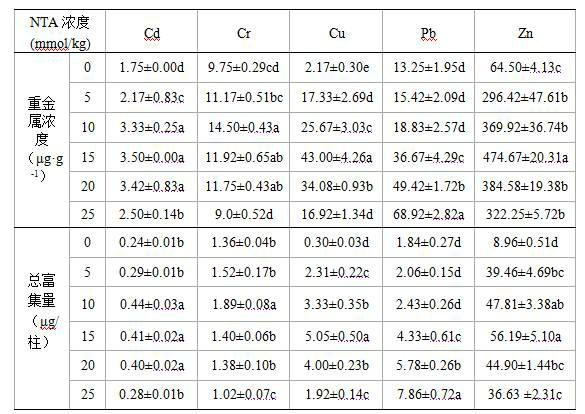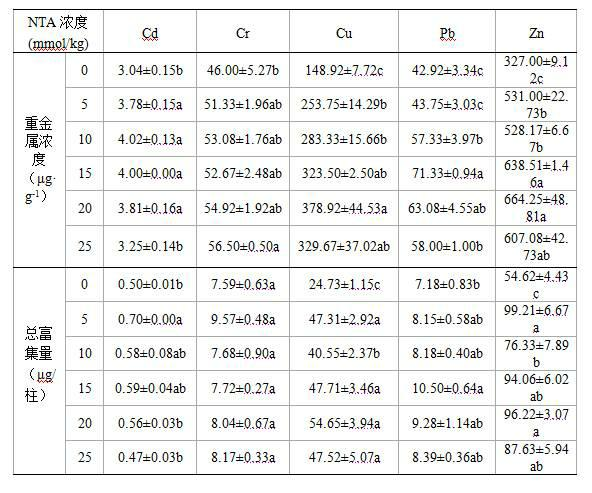Method adopting ammonia carboxy chelating agent and festuca arundinacea to restore compost matrix heavy metals
A carboxyl chelate and heavy metal technology, applied in botany equipment and methods, applications, gardening, etc., can solve the problems of polluting deep soil and groundwater, pollution, difficult light, chemical substances, and biodegradation
- Summary
- Abstract
- Description
- Claims
- Application Information
AI Technical Summary
Problems solved by technology
Method used
Image
Examples
Embodiment 1
[0047] In this experiment, a common turf plant in northern my country, tall fescue ( Festuca arundinacea L.). The culture substrate is domestic waste compost, air-dried, passed through a 2 mm sieve, and set aside. The physical and chemical properties of compost are: pH 7.62, organic matter content 12.12%, total nitrogen 5.18%, available phosphorus 77.92 mg / kg, total potassium 50.83 g / kg, saturated water content 0.76 mL / g, bulk density 0.85 g / mL; heavy metals Cd, Cr , Cu, Pb, Zn contents are 1.97, 67.00, 238.73, 172.11 and 496.38 respectively mu g / g. Other embodiments are the same below.
[0048] (1) Add 20 g of the prepared compost to a petri dish with a diameter of 6 cm, and apply the sodium salt of ammonia triacetic acid (NTA) with a concentration of 5 mmol kg-1 ammonia carboxylate chelating agent in the compost matrix;
[0049] (2) Choose tall fescue seeds with full grains, 50 seeds per dish;
[0050] (3) Put the petri dish with seeds in the laboratory to germinate,...
Embodiment 2
[0053] (1) Add 20 g of prepared compost to a petri dish with a diameter of 6 cm, and apply a concentration of 15 mmol kg in the compost matrix -1 Ammonia chelating agent is the sodium salt of nitrilotriacetic acid (NTA);
[0054] (2) Choose tall fescue seeds with full grains, 50 seeds per dish;
[0055] (3) Put the petri dish with seeds in the laboratory to germinate, water once a day in the morning and evening, and change the position of each petri dish frequently to ensure consistent light. During the cultivation period, the light intensity is 800 mu mol?m -2 ?s -1 , the laboratory temperature is 124°C, and the relative humidity is 55%;
[0056] (4) TAS-990 atomic absorption spectrophotometer was used to determine the content of various heavy metals.
Embodiment 3
[0058] (1) Add 20 g of prepared compost to a petri dish with a diameter of 6 cm, and apply a concentration of 20 mmol kg in the compost matrix -1 Ammonia chelating agent is the sodium salt of nitrilotriacetic acid (NTA);
[0059] (2) Choose tall fescue seeds with full grains, 50 seeds per dish;
[0060] (3) Place the petri dish with seeds in the laboratory to germinate, water once a day in the morning and evening, and change the position of each petri dish frequently to ensure consistent light. During the cultivation period, the light intensity is 700 mu mol?m -2 ?s -1 , the laboratory temperature is 20°C, and the relative humidity is 45%;
[0061] (4) TAS-990 atomic absorption spectrophotometer was used to determine the content of various heavy metals.
PUM
 Login to View More
Login to View More Abstract
Description
Claims
Application Information
 Login to View More
Login to View More - R&D
- Intellectual Property
- Life Sciences
- Materials
- Tech Scout
- Unparalleled Data Quality
- Higher Quality Content
- 60% Fewer Hallucinations
Browse by: Latest US Patents, China's latest patents, Technical Efficacy Thesaurus, Application Domain, Technology Topic, Popular Technical Reports.
© 2025 PatSnap. All rights reserved.Legal|Privacy policy|Modern Slavery Act Transparency Statement|Sitemap|About US| Contact US: help@patsnap.com


